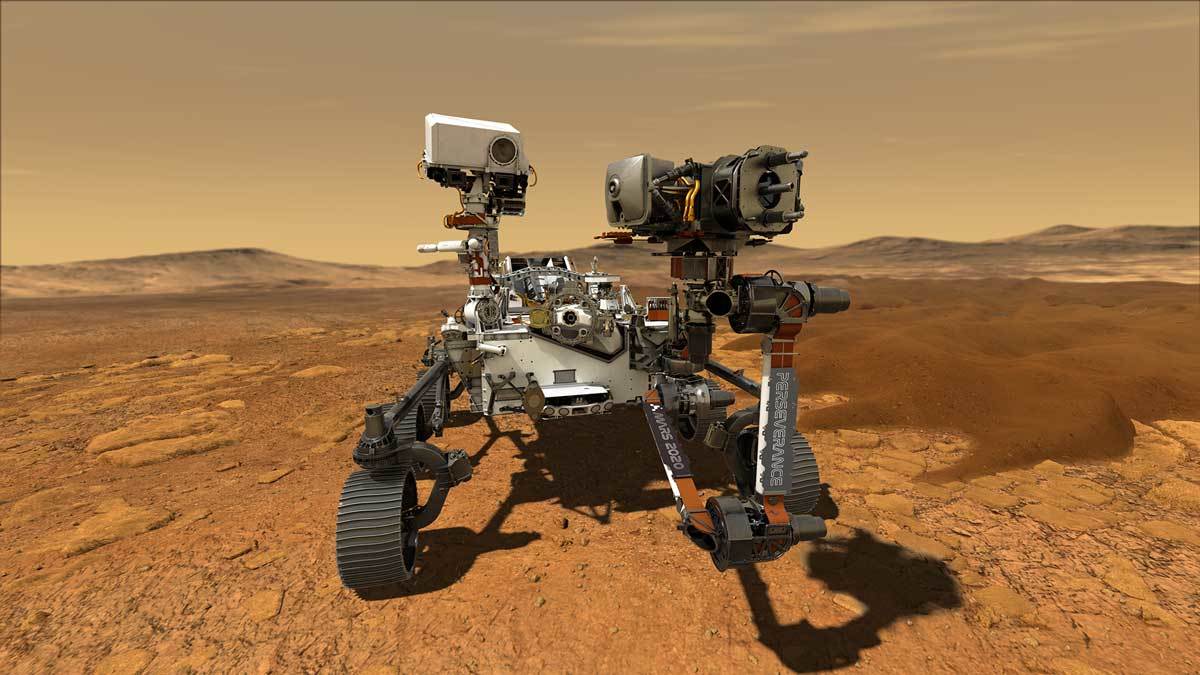Mars 2020 Mission, Perseverance Rover Launch on July 30.
 |
Illustration depicting NASA's Perseverance rover operating on the surface of Mars (Image Source: NASA/JPL-Caltech) NASA's next Mars rover just cleared a big hurdle on the path toward its planned launch next week.The $2.7 billion Mars 2020 Perseverance rover mission passed its flight readiness review (FRR) Wednesday (July 22), keeping the mission on track to lift off from Florida's Cape Canaveral Air Force Station on July 30, NASA officials announced. |
With Perseverance, its most complex Mars rover to date, NASA is opening a new chapter in the search for traces of ancient life on Mars.The launch of the new rover is scheduled to take place on 30 July 2020 at 13:50 CEST [11:50 UTC/7:50 am US EDT] on board an Atlas V launch vehicle from Cape Canaveral in Florida. Then, on 18 February 2021, it will land in Mars' Jezero crater.The German Aerospace Center (Deutsches Zentrum fuer Luft- und Raumfahrt; DLR) is represented on the Mars 2020 mission science team and is involved in evaluating the data and images. The aim of the mission is to analyse rock and sediment samples to determine more precisely when Mars may have had ideal conditions for microorganisms to thrive.
The Mars 2020 mission with its Perseverance rover is part of NASA's Mars Exploration Program, a long-term effort of robotic exploration of the Red Planet. The Mars 2020 mission addresses high-priority science goals for Mars exploration, including key Astrobiology questions about the potential for life on Mars. The mission takes the next step by not only seeking signs of habitable conditions on Mars in the ancient past, but also searching for signs of past microbial life itself. The Perseverance rover introduces a drill that can collect core samples of the most promising rocks and soils and set them aside in a "cache" on the surface of Mars.
A future mission could potentially return these samples to Earth. That would help scientists study the samples in laboratories with special room-sized equipment that would be too large to take to Mars. The mission also provides opportunities to gather knowledge and demonstrate technologies that address the challenges of future human expeditions to Mars. These include testing a method for producing oxygen from the Martian atmosphere, identifying other resources (such as subsurface water), improving landing techniques, and characterizing weather, dust, and other potential environmental conditions that could affect future astronauts living and working on Mars.
 |
| Ingenuity Mars Helicopter on the Martian Surface (Artist's Concept) |
NASA is ready to take its first spin at flying a helicopter on another world as the agency's Mars helicopter, Ingenuity, prepares for launch in July.The helicopter is part of NASA's Mars 2020 mission, the star of which is the Perseverance rover, a robot designed to help scientists determine whether life on the Red Planet has ever been possible. Ingenuity isn't a core tool for that objective, but it's hitching a ride with the rover to test NASA's ability to fly on another world.
Ingenuity has been in the works for six years, but now it's attached to the underside of the rover, where it will remain for the long journey to the Red Planet, Mimi Aung, lead engineer for Ingenuity, said during the news conference. After the spacecraft arrives at Mars in February 2021 and endures the same "seven minutes of terror" that NASA's Curiosity rover faced when landing on the Red Planet in 2012, Ingenuity will separate itself from the main rover.
When it tries to take flight, Ingenuity will be at least 160 feet (50 meters) away from the rover itself, Matt Wallace, deputy project manager for the Mars 2020 mission, said during the news conference. However, Perseverance will be able to monitor the flight attempts using some of its 23 onboard cameras; whether Ingenuity can spot the rover from flight remains to be seen
- Mission Name: Mars 2020
- Rover Name: Perseverance
- Main Job: The Perseverance rover will seek signs of ancient life and collect rock and soil samples for possible return to Earth.
- Launch Window: July 30 - Aug. 15, 2020
- Launch Location: Cape Canaveral Air Force Station, Florida
- Landing: Feb. 18, 2021
- Landing Site: Jezero Crater, Mars
- Mission Duration: At least one Mars year (about 687 Earth days)
- Tech Demo: The Mars Helicopter is a technology demonstration, hitching a ride on the Perseverance rover.

Comments
Post a Comment